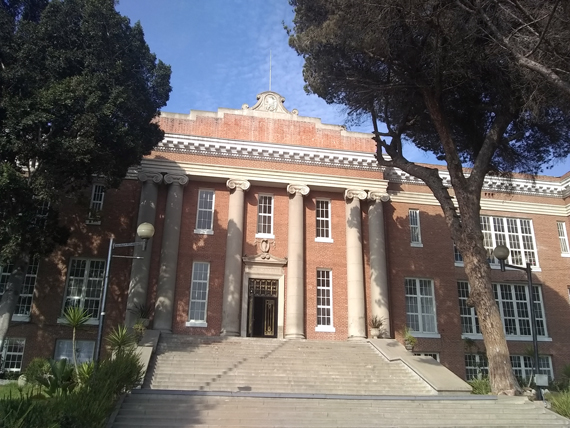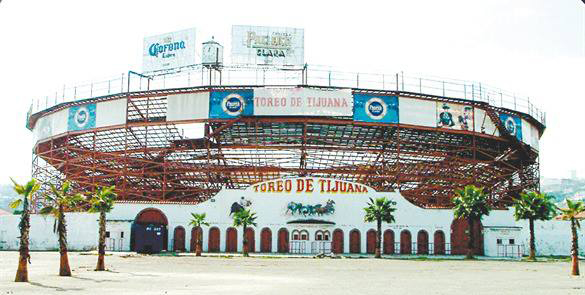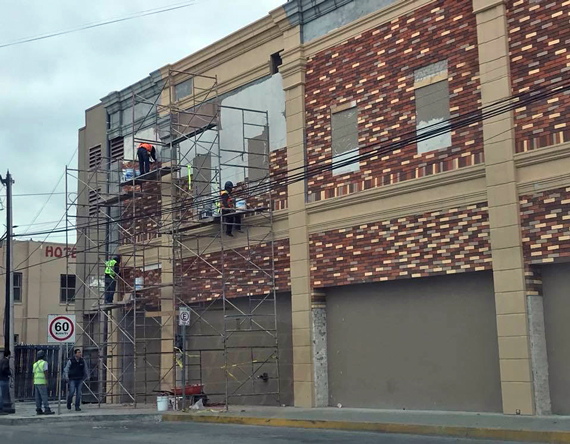|
Tijuana Dreaming: Preservation Meets Development
July/August 2018
By Maria Curry
 Tijuana's historic Casa de Cultura, where the SDAF panel was held. Photo by Maria Curry |
 Tijuana's bullring, demolished 2006. Photo courtesy of El Viejo Tijuana Facebook page |
 Building in Tijuana on Calle Segunda between Hotel St. Francis (1904) and Hotel Comercial (1928) being made to look historic with the addition of bricks resembling those of the Hotel Comercial facade. Photo by Maria Curry. |
For the first time, the San Diego Architectural Foundation (SDAF) presented its annual "Context" forum, aimed at improving the built environment, across the international border. "The Tijuana Renaissance/El Renacimiento de Tijuana, Context Vol. 5," held June 1, highlighted some of Tijuana's most exciting architecture and cultural advances in recent years, and brought preservation issues to the forefront.
The day-long program included a trans-border bus tour for 100 people visiting architecturally relevant buildings, an architecture exhibit, a musical event, a culinary fair and reception at the historic Casa de la Cultura (1929), and a forum with speakers from both sides of the border. Participants discussed whether Tijuana and San Diego are one or two cities sharing planning and development challenges; downtown revitalization, Guadalupe Valley's new architecture and designs for tourism; and the quality of the wine, art, and culinary industries.
Thanks to a kind invitation from SDAF, I was speaker for a panel titled "Urban Explosion," with panelists Greg Strangman. creator of LWP Group, Inc.; Jose Antonio Diaz, principal of Provive; and Genaro Valladolid from Bustamante Realty Group. Strangman is a successful architect who acquires, renovates and manages properties in San Diego including historic buildings. He is also remodeling old buildings in Tijuana. Diaz buys abandoned houses from low-income neighborhoods in various cities in Mexico and sells them after repair, and also improves the areas with community support. Valladolid is Bustamante Realty Group's main promoter of properties for sale and rent.
Early this year, I met with BRG principal Hector Bustamante and Valladolid at their Tijuana office. They wanted to address my complaints about the lack of historic preservation standards in the treatment of old buildings. We had a very positive conversation where they showed support and interest in protecting historic properties and asked me to come back to conduct a one-day training for their 40 employees. However, time passed and a date for the training was never set. Meanwhile, alterations to significant Tijuana buildings continued.
At Context Vol. 5, I was able to reconnect with them, and now we are talking about the adaptive reuse of a building built in 1957. I also met developers, urban planners, and architects in charge of Tijuana projects. Context was a great opportunity for dialogue about the overlapping interests of development and history.
During the panel, I mentioned that the urban explosion in downtown Tijuana started in 2006, when the iconic old bullring (1938) was demolished, ushering in an era of intense development in the so-called Golden Zone in Tijuana along the old Boulevard Agua Caliente. This area has one of the highest real estate values in the city and intersects its oldest neighborhoods with hundreds of still not documented, culturally valuable buildings. Many high-rise buildings are going up in these neighborhoods, replacing abandoned, old structures.
I noted that the bullring's owner never wanted to discuss the preservation of this treasure with the community, nor any possibilities of mitigation, despite loud public outcry. SOHO placed the bullring on its Most Endangered List. All was to no avail. After a two-year legal battle based on Baja California State preservation law, the then-director of urban administration who disregarded due process and allowed the bullring's destruction was banned from public employment for ten years.
The lack of dialogue between developers and preservationists continued to affect Tijuana's historic image after we lost the bullring. That is why during the panel I invited the architects, planners, and developers present to use their talents for creative, adaptive reuse projects in historic buildings. I mentioned the need to identify, document, and evaluate before demolishing or changing existing structures that might bear historic significance. Strangman mentioned his experience adapting old buildings for new uses and Diaz told how he worked with people and institutions to create safe, quality urban environments. I plan to continue these conversations with these professionals in the near future.
I made another valuable discovery at Context. Some architects at the event read SOHO's eNews and one serves on the City of San Diego Historical Resources Board. Their sensibility played an important role in allowing the voice of preservation to be heard in this unique event. We need to keep this discussion alive to preserve and protect important historic resources and improve the quality of life in our region.
|
2025
2024
2023
2022
2021
2020
2019
2018
2017
2016
2015
|






